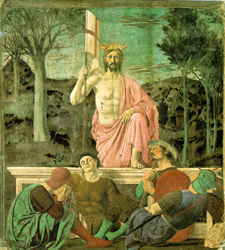 |
Resurrection Piero della Francesca, 1463 |
Easter is the most important festival of the year for Christians, as it commemorates the event that is at the very heart of the faith: the resurrection of Jesus Christ.
The four books of the New Testament known as the Gospels tell the story of Jesus’ trial by the Romans, how this teacher from the province of Galilee was condemned to death, and how, when some women visited his grave on the Sunday following his crucifixion, they found the tomb—the cave where he had been buried (which had been blocked by a stone to protect the body)—empty.
Such was his impact that for days after they found the abandoned tomb people reported encounters with him, experiences which led his followers to believe that God had raised him from the dead, that he was indeed the Messiah that had long been awaited. For Christians, Jesus died on the cross so that humanity could be granted eternal life. And it is this promise—of a life after death—that is at the core of Christian belief, a mystery that is celebrated on Easter, often in sunrise services when worshippers greet the day with expressions of great joy.
Although most Christian festivals are based on the solar calendar, the date of Easter varies year to year, which also affects the dates of related observances such as Lent. The tradition of giving eggs—symbolic of new life—dates from pre-Christian times, as does the Easter ‘bunny’, a taming of the wild hare who was an animal sacred to the goddess (see Ostara).
For more, see The empty tomb, or view the complete spotlight on sacred history.